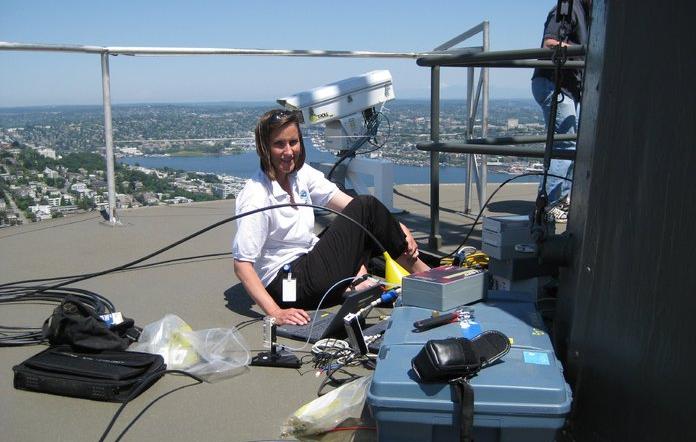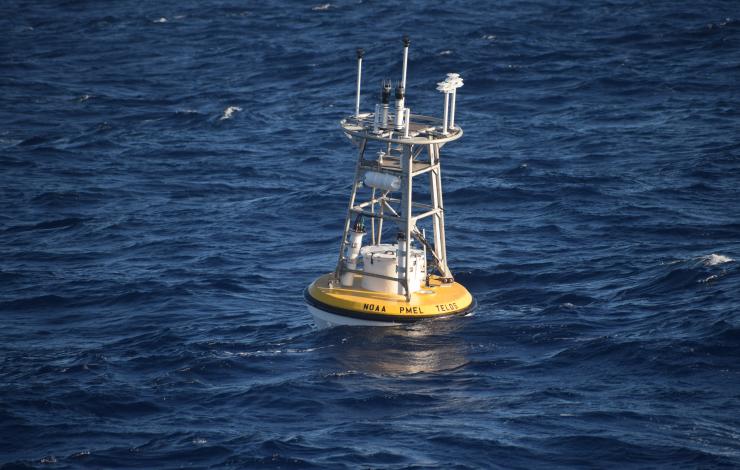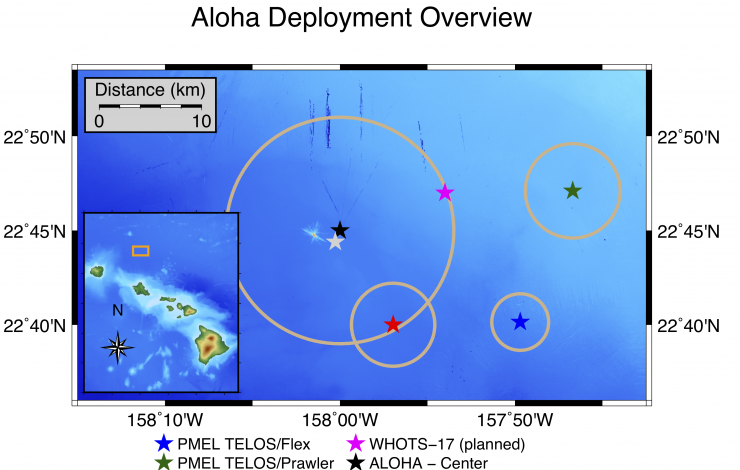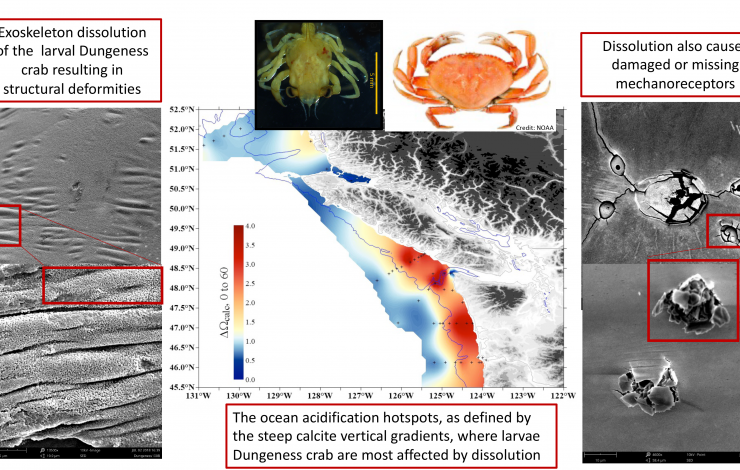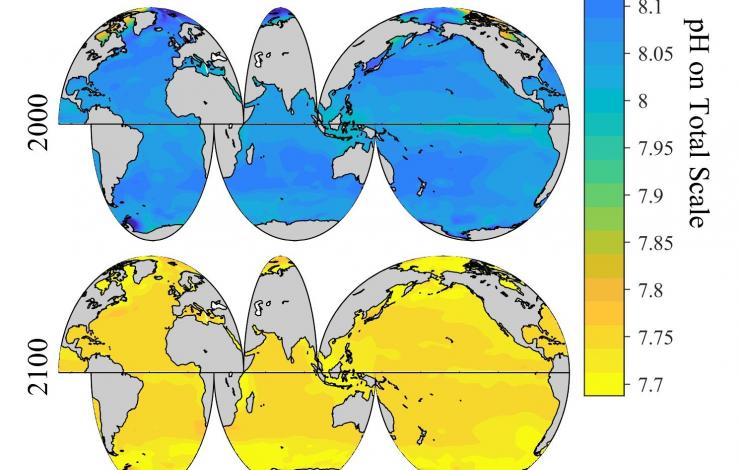What's New Archive
Aerosols are fine particles that are produced by waves breaking at the ocean surface (sea spray), phytoplankton (sulfate aerosol), sandstorms (dust), and combustion (burning of fossil fuels and wildfires). These microscopic particles can impact climate directly by absorbing or scattering incoming solar radiation and indirectly by affecting cloud properties such as extent, lifetime, and reflectivity. Aerosols also affect air quality by reducing visibility and, when inhaled, can affect our health.
The Atmospheric Chemistry Group at NOAA’s Pacific Marine Environmental Lab has been studying the effects of aerosols on climate and air quality by participating in shipboard national and international research field campaigns and long-term aerosol monitoring for over thirty years. Their work has employed the use of ships, unmanned aerial systems (UAS), and ground stations.
The group has studied a broad range of aerosol types ranging from remote marine aerosols in every ocean basin, black carbon (soot) in the Arctic, particulate matter in the oil and gas fields of Utah’s Uintah Basin to dust storms over Asia.
Check out our video on the NOAA YouTube Channel to learn more about NOAA PMEL’s research on aerosols: https://www.youtube.com/watch?v=pp_TdS8RPZI
Online registration for the 2020 NOAA Science Camp is now open! NOAA Science Camp is held at the NOAA Western Regional Center in Seattle, WA and exposes middle school and high school students to the various research conducted at NOAA through hands-on science activities and emphasizing solutions to real-world scenarios. The Middle School Science Camp offers two, one-week sessions from July 6-10 and July 13-17, 2020. The Junior Leadership Program is a two-week program (July 6-17) for high school students entering grades 9-12 in the fall of 2020. Applications for the Junior Leadership Program are due on April 10th. Camp runs from 9 am to 4 pm each weekday. Scholarships are available for both programs.
PMEL scientists (NOAA and JISAO) lead activities relating to oceanography including what scientists do when they go to sea, various tools and techniques scientists use to study the ocean, and how currents and trace chemicals move throughout the ocean.
Learn more on the Washington Sea Grant site and register for NOAA Science Camp here.
Stacy Maenner Jones has been selected February's NOAA Employee of the Month!
Stacy is a Physical Scientist at PMEL in Seattle, Washington, where she has been instrumental in the development of the moored and autonomous ocean CO2 program, and coordinates the program’s observations, timely public access to real-time and finalized data, and sensor and observing platform development. Stacy is an essential liaison among engineers, industry partners, and scientists around the world, and has made NOAA’s moored CO2 observations central to the global surface ocean CO2 network. Last year, Stacey made major contributions to six Saildrone missions, including the first autonomous Antarctic circumnavigation, and oversaw a 550-day Wave Glider mission in an area where there was a critical surface ocean CO2 observational gap in the South Pacific Ocean. Moreover, Stacy led the testing and validation of a new autonomous surface ocean CO2 sensor, which NOAA has begun sharing with partners and stakeholders. Stacy’s wealth of institutional knowledge and her facility with handling complex technical issues is critical to meeting NOAA’s goals of understanding changing ocean and climate conditions, and supporting healthy oceans, coastal ecosystems, and marine resources.
Congratulations, Stacy!
The northern Bering and Chukchi Seas are among the world’s most productive ocean areas. They are home to millions of seabirds and marine mammals and vibrant Indigenous cultures. The region has also long been one of the fastest warming places on the planet. In a recnetly published paper in Nature Climate Change, a multi-disciplinary team of academic, government, and private sector scientists reports that dramatic changes in these Arctic ecosystems due to warmer ocean conditions. The scientific team, participating in a four-year Arctic Integrated Ecosystem Research Program, observed conditions more typical of subarctic ecosystems.
"The rate of change over the study timeframe came as a shock. Having a team with the expertise to put together the pieces across the whole ecosystem simply drives home how far-reaching the changes are and how much they matter," said Henry Huntington, lead author of the study.
Some key observations over the past several years of the study include:
- Near-bottom waters that typically remained close to freezing year-round have in the past four years warmed for several months in the summer and fall.
- Sea ice that used to start forming each fall has been absent or sparse into January and February and the spring ice retreat was earlier than normal in recent years.
- Juvenile Arctic Cod, which dominate pelagic fish communities in the northern Chukchi Sea, were substantially more abundant in 2017 than in 2012 and 2013.
- In 2017 pink salmon were observed to have increased dramatically in abundance in the northern Bering Sea
- Bowhead whales that typically migrate south of St. Lawrence Island were observed year-round north of the Bering Strait.
- Ice seals were absent from vast portions of some of their main breeding areas, and dead seals were reported in unusually high numbers on the Bering and Chukchi coasts.
The North Pacific Research Board, in cooperation with other organizations funded the Arctic Integrated Ecosystem Research Program. The goal of the program was to better understand the mechanisms and processes that structure the ecosystem and influence the distribution, life history, and interactions of biological communities in the Chukchi Sea. Previous integrated ecosystem programs were undertaken in the Bering Sea and Gulf of Alaska.
The big question for scientists remains whether these changes reflect a new norm. Collaborative research efforts like this are important because they allow scientists to monitor changes as they are happening and provide meaningful information to local communities and resource managers so they are better able to respond and adapt.
The team of authors includes physical and biological oceanographers, ichthyologists, ornithologists, marine mammalogists, marine ecologists, and social scientists, from the University of Alaska Fairbanks, the University of Washington, the National Oceanic and Atmospheric Administration, the Alaska Department of Fish and Game, the North Slope Borough Department of Wildlife Management, the North Pacific Research Board, Stantec, and Huntington Consulting.
PMEL's EcoFOCI program was involved with the study. EcoFOCI is a joint research program between NOAA's Pacific Marine Environmental Lab and NOAA's Alaska Fisheries Science Center. EcoFOCI scientists integrate field, laboratory and modeling studies to determine how varying biological and physical factors influence large marine ecosystems within Alaskan waters.
Read the full press release here.
41 scientists from PMEL, including scientists from NOAA's cooperative institutes at the University of Washington's Joint Institute for the Study of the Ocean and Atmosphere (JISAO) and Oregon State University's Cooperative Institute for Marine Resources Studies (CIMRS), the National Research Council, graduate and undergraduate students are heading to the Ocean Sciences Meeting in San Diego to share their current research. Talks and posters cover a range of topics include saildrone research, ocean observing systems, marine heatwaves, Arctic, acoustics, Deep Argo, genetics and genomics, El Nino, hydrothermal vents, methane, nutrients, technologies, ocean carbon and data management.
The 2020 Oceans Science Meeting is the flagship conference for the ocean sciences and the larger ocean-connected community. As we approach the UN Decade of Ocean Science for Sustainable Development, beginning in 2021, it is increasingly important to gather as a scientific community to raise awareness of the truly global dimension of the ocean, address environmental challenges, and set forth on a path towards a resilient planet. The meeting is co-sponsored by the American Geophysical Union (AGU), the Association for the Sciences of Limnology and Oceanography (ASLO), and The Oceanography Society (TOS).
PMEL research groups that will be present at the conference are: Acoustics, Arctic including Innovative Technology for Arctic Exploration, Climate-Weather Interface, Earth-Ocean Interactions, EcoFOCI, Engineering, Genetics and Genomics, Global Tropical Moored Buoy Array, , Large Scale Ocean Physics, Ocean Carbon, Ocean Climate Stations, Pacific Western Boundary Currents, and Science Data Integration Group.
On November 20, 2019, a team of PMEL scientists, engineers, and technicians successfully deployed two deep water oceanographic moorings off the coast of Hawaii to test PMEL’s newest data acquisition system, known as TELOS (Telemetry, Electronics & Logging of Oceanographic Sensors). The “brain” behind oceanographic data collection, TELOS interfaces with the atmospheric and oceanic sensors aboard the moorings -- collecting, storing, and transmitting measured data in real-time via satellite telemetry.
Station ALOHA, located 90 miles north of Oahu, is a well-established hub of ocean research. The site contains a cabled array seafloor observatory, a Woods Hole Oceanographic Institution surface mooring (WHOTS), long-range profilers, autonomous gliders, and other equipment. With the abundance of ocean observations on site, frequent ship visits, and ease of access from a US port to ocean depths greater than 4,500 meters (nearly 3 miles), the site offers an ideal testbed to evaluate the new TELOS technology.
The two deployments near Station ALOHA represent the first-ever open-ocean moorings with TELOS. One mooring contains a standard set of 13 line-mounted temperature/salinity instruments at depths ranging from 1 meter to 500 meters, two current meters, and a full suite of six meteorological instruments similar to the instrumentation on well-established Global Tropical Moored Buoy Array and Ocean Climate Stations moorings. A backup data acquisition system with a duplicate suite of six meteorological instruments is deployed on this mooring for comparison to an established control system. The second mooring also includes the standard set of 6 meteorological instruments and features a PMEL subsurface Prawler device that crawls up and down the mooring line, transmitting upper-ocean temperature/salinity profile data and potentially replacing the need for multiple in-line instruments. Both moorings will be evaluated over the 1-year deployment period to compare the data acquisition systems, using measurements from both moorings as well as the WHOTS mooring for additional comparison. TELOS has already demonstrated the capability to collect, process, and return higher volumes of real-time data than previous data acquisition systems, with the additional capacity for integrating new instrumentation.
So far, the mission has been a success. High-resolution real-time data are transmitted to PMEL via satellite, and scientists are developing visualization tools and analyzing data quality. The full data payload will be downloaded from the moorings in late 2020, testing the ability to survive a yearlong deployment at sea. If successful, TELOS will be scaled up for implementation across the PMEL mooring networks, transforming the future of oceanographic data collection.
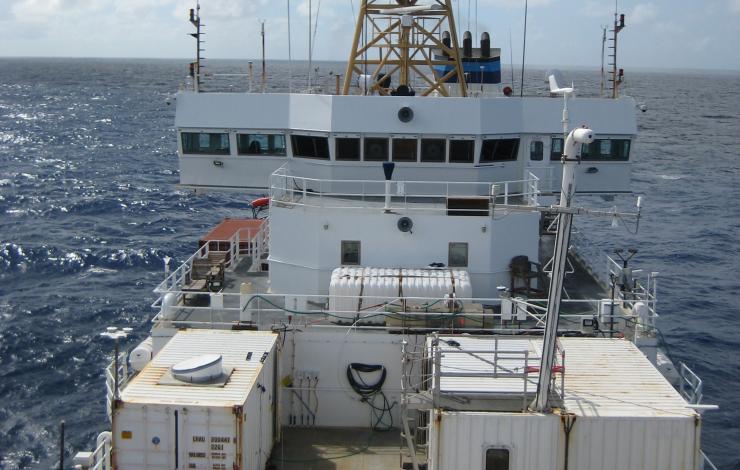
A view of the ship from the top of the forward mast. From left to right on the lower deck is the NOAA ESRL radar container with upward-pointing W-band radar measuring clouds and rain, the NOAA ESRL CSD lidar measuring wind, aerosol and clouds, and the NOAA PMEL air quality sampling van with aerosol inlet. (Photo: Sergio Pezoa)
Scientists will use instruments aboard NOAA Ship Ronald H. Brown, NOAA WP-3D Orion aircraft, several autonomous vehicles, as well as ocean surface floats to investigate how the ocean, atmosphere, and shallow clouds work together to create the weather and climate we live in.
PMEL's Atmospheric Chemistry Group has been participating in the Atlantic Tradewind Ocean-Atmosphere Mesoscale Interaction Campaign (ATOMIC) onboard the RV Ronald H. Brown in the tropical North Atlantic east of Barbados.
The six-week scientific campaign involves a unique combination of manned and unmanned aircraft and ships including newly developed capabilities using UAVs, saildrones, and underwater gliders to investigate how the ocean, atmosphere, and shallow clouds work together to create the weather and climate we live in. Scientists are gathering information on shallow convection clouds, the effects of aerosols and clouds on the ocean surface energy budget, and mesoscale oceanic processes – all of which are relevant to the propagation of Madden-Julian Oscillations (MJOs), hurricane track and intensity, annual movement of the Intertropical Convergence Zone (ITCZ), midlatitude storm tracks, and marine stratocumulus cloud regions.
PMEL is measuring aerosol properties including number concentration as a function of particle size, chemical composition, scattering and absorption of solar radiation, and cloud drop nucleating ability. These data will be used to investigate the impacts of aerosol particles on the region’s radiation budget and, in turn, the impact of atmospheric dynamics on aerosol properties.
ATOMIC is the U.S. component of a collaborative effort that includes Germany, France, United Kingdom, United States, and Barbados called EUREC⁴A (Elucidating the Role of Clouds-Circulation Coupling in Climate). Together, ATOMIC and EUREC4A will involve 4 research vessels, 4 research aircraft (including the NOAA P3), land-based observations from Barbados, and unmanned sea-going vehicles. ATOMIC involves experts from NOAA (PMEL and ESRL), NOAA pilots and crew, the Caribbean Institute for Meteorology and Hydrology, several universities, and other partners.
Dr. Patricia Quinn has been serving as Chief Scientist for Leg 1. Read more on NOAA research: https://research.
A new NOAA-funded study has documented for the first time that ocean acidification along the US Pacific Northwest coast is impacting the shells and sensory organs of some young Dungeness crab, a prized crustacean that supports the most valuable fishery on the West Coast.
Analysis of samples collected during a 2016 NOAA research cruise identified examples of damage to the carapace, or upper shell, of numerous larval Dungeness crabs, as well as the loss of hair-like sensory structures crabs use to orient themselves to their surroundings.
Prior to this study, scientists thought that Dungeness crab were not vulnerable to current levels of ocean acidification, although a laboratory study conducted on Dungeness crab larvae by NOAA’s Northwest Fisheries Science Center in 2016 found that their development and survival suffered under pH levels expected in the future.
“This is the first study that demonstrates that larval crabs are already affected by ocean acidification in the natural environment, and builds on previous understanding of ocean acidification impacts on pteropods,” said lead author Nina Bednarsek, senior scientist with the Southern California Coastal Water Research Project. “If the crabs are affected already, we really need to make sure we start to pay much more attention to various components of the food chain before it is too late.”
In this study, examination under a high-magnification, scanning electron microscope revealed that the corrosive conditions of coastal waters had affected portions of the fragile, still-developing external shell and legs of the tiny, almost translucent post-larval Dungeness crabs, leaving tell-tale features, such as abnormal ridging structures and scarred surfaces. This could, in turn, impair larval survival by altering swimming behaviors and competence, including the ability to regulate buoyancy, maintain vertical position, and avoid predators.
One of the more important findings of this study was that crabs showing signs of carapace dissolution were smaller than other larvae. This was disconcerting, scientists said, because the damage during the crab’s larval stages could cause potential developmental delays that could increase energy demands and interfere with maturation.
In a surprising discovery, the team found that the low pH water in some coastal areas damaged the canals where hair-like bristles called mechanoreceptors stick out from the shell. These receptors transmit important chemical and mechanical sensations to the crab, and may help crabs navigate their environment. Examination showed that carapace dissolution destabilizes the attachment of the mechanoreceptor anchor, resulting in them falling out in some individuals.
This is a new aspect of crustacean sensitivity to ocean acidification that has not been previously reported. The team hypothesize that the absence or damage of mechanoreceptors within their neuritic canals may in part explain potential aberrant behavioral patterns, such as slower movement, less tactile recognition, and prolonged searching time, as well as impaired swimming, that have been observed in various crustacean species exposed to low pH conditions in laboratory settings.
“We found dissolution impacts to the crab larvae that were not expected to occur until much later in this century,” said Richard Feely, Senior Scientist with NOAA’s Pacific Marine Environmental Laboratory and one of the co-authors of the study.
Combining observations and modelling work, the research team, which included scientists from JISAO, NOAA’s cooperative institute at the University of Washington, from the University of Connecticut, and from Quebec, Britain and Slovenia, demonstrated that the impacts of dissolution were the most severe in the coastal habitats, where crabs grow and mature.
Read the full story on NOAA Research: https://research.noaa.gov/article/ArtMID/587/ArticleID/2581/Dungeness-crab-showing-impact-of-coastal-acidification
Voices of the North: M2 “Peggy” mooring celebrates 25 years of providing the pulse of the Bering Sea
This past fall, NOAA PMEL's Ecosystems and Fisheries-Oceanography Coordinated Investigations (EcoFOCI) program recovered a surface mooring “Peggy” at the biophysical mooring site 2 (M2) adding a prestigious marker to this time series by providing near-continuous, year-round measurements of the southeastern Bering Sea since 1995. Moorings, like M2, give researchers an expanded view of the remote corners of the world's oceans, in this case, measuring temperature, salinity, nitrate, chlorophyll, and currents in this highly productive area. Data used from M2 have been instrumental in studying the loss of sea ice in the Bering Sea, understanding the physics of the Cold Pool and developing the Oscillating Control Hypothesis.
The Bering Sea supports large marine mammal and bird populations and some of the most profitable and sustainable commercial fisheries in the United States. Continuous monitoring of oceanographic conditions from this region provides critical data to support sustainable management of these living marine resources in the Bering Sea.
On March 13, 1995, the M2 surface mooring, nicknamed ‘Peggy’, was deployed from the NOAA Ship Miller Freeman. The surface buoy pays homage to Peggy Dyson, who for 25 years, from her home in Kodiak, Alaska, reported the weather, family messages, and sometimes even paid bills for the mariners of the North Pacific Ocean. She began the radio calls on WBH-29 in 1974 for her husband, late commercial fishing pioneer Oscar Dyson (namesake of the NOAA Ship Oscar Dyson), to give him weather reports. Peggy became the ‘voice of the north’ and even worked with the NOAA weather service to provide real-time ship-to-shore information to aid forecasters in refining their data, which she did until 1999.
This is a true testament to the regionally focused fisheries-oceanography research program, EcoFOCI, in forecasting the need for long-term monitoring of the Bering Sea as well as providing strong science, information fisheries recruitment and implications to regional fisheries management councils. With the enhancement of Arctic-driven technologies at NOAA's Pacific Marine Environmental Laboratory, it is now possible to enhance the M2 site while continuing to meet the goals and responsibility of NOAA and provide solid science for the management of Alaska’s marine ecosystems.
Visit the EcoFOCI website for more information about research done in the Bering Sea, Gulf of Alaska, and Arctic waters.
New research by NOAA, the University of Maryland, and international partners published in Nature Scientific Reports shows that the changing chemistry of seawater has implications for continued greenhouse gas absorption.
The ocean has been playing an important role in helping slow down global climate change by removing the greenhouse gas carbon dioxide (CO2) from the atmosphere. However, decades of ocean observations show that the CO2 absorbed by the ocean is changing the chemistry of seawater, a process known as ocean acidification. The study discusses the reduced buffering capacity of the ocean as pH levels drop and its implications for reducing the ocean’s role as a CO2 sink in the future.
The researchers from NOAA's PMEL and NCEI and research institutions in Norway stress the importance of leveraging in situ observation-based global pH data products to help improve model projections. A climatology developed from this research may lead to more preventive and adaptive solutions to reduce carbon dioxide emissions and, at the same time, allow for ocean acidification adaptation strategies in regional areas.
The CO2 Problem
Ocean acidification occurs when the ocean absorbs carbon dioxide from the atmosphere. Anthropogenic, or human-caused, carbon dioxide comes from greenhouse gas emissions. Emissions from the burning of fossil fuels, cement production, and deforestation have pumped about two trillion tons of carbon dioxide into the atmosphere since the beginning of the Industrial Revolution. Deforestation adds to the issue by contributing about 10 percent of all carbon dioxide emissions. The deforestation of the Amazon rainforest has a particularly devastating effect on rising CO2 levels.
The ocean has taken up about 25 percent of the excess gas, the equivalent of over 600 billion tons of carbon dioxide, from 1750 to 2015. As atmospheric CO2 levels increase, so do the levels in the ocean.
When seawater absorbs carbon dioxide its acidity is increased, which decreases the building blocks used by shellfish to grow their shells. Some studies have shown that ocean acidification has negative implications for marine life, particularly clams, mussels, coral reefs, and small sea snails, which could have difficulty building or maintaining their shells in increasingly acidic waters.
A Decreasing Buffer
The capacity of ocean waters to take up surplus anthropogenic CO2 has been decreasing rapidly. This study suggests that the ocean’s “buffer capacity” could decrease by as much as 34 percent from 2000 to 2100 under the Intergovernmental Panel on Climate Change (IPCC) RCP8.5 scenario, which is the highest “Representative Concentration Pathway” of potential greenhouse gas emissions and atmospheric concentration levels through 2100. The rapid decrease in this "buffer capacity" suggests that while the ocean will likely continue to take up more CO2 in the future due to the increasing atmospheric CO2 concentrations, the proportion of anthropogenic carbon dioxide entering the ocean will decrease. The ocean’s role in buffering global climate change will gradually diminish, and ocean acidification could accelerate.
Improving Trajectories
The study is the first of its kind to link modern observed pH data with modeled carbon dioxide projections to provide a high-resolution regional view of the pH trajectory in all locations of the global surface ocean.
The work will provide improved regional ocean acidification trajectories, above what the model output could produce alone. Comparison with the model outputs show that this climatology could improve pH projection by up to ~0.06 pH units at certain locations of the global ocean, equivalent to a 15 percent acidity difference, or ~3 decades of pH change.
Funding for this study was provided by NOAA's Ocean Acidification Program and Ocean Observing and Monitoring Division. Along with NOAA, researchers were affiliated with the Earth System Science Interdisciplinary Center (ESSIC) at the University of Maryland and the Joint Institute for the Study of the Atmosphere and Ocean at the University of Washington, both NOAA cooperative institutes, as well as, NORCE Norwegian Research Centre, Bjerknes Centre for Climate Research, Bergen, Norway, and Geophysical Institute, University of Bergen.



